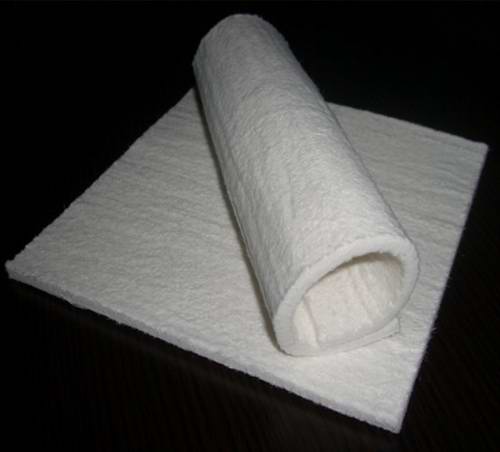A research team from the National University of Singapore’s (NUS) Faculty of Engineering has achieved a world’s first by successfully converting paper waste into green cellulose aerogels that are non-toxic, ultralight, flexible, extremely strong, and water repellent.
The novel material is ideal for applications such as oil spill cleaning, heat insulation as well as packaging, and it can potentially be used as coating materials for drug delivery and as smart materials for various biomedical applications.
This pioneering work was achieved by a team led by Assistant Professor Duong Hai Minh from the Department of Mechanical Engineering.
“Aerogels, which are among the lightest solid materials known to man, are one of the finest insulation materials available,” says Duong Hai Minh, an NUS assistant professor who led the pioneering work. “Traditional aerogels are mainly made of silica, which is not environmentally-friendly. In contrast, cellulose is low cost and makes up 75% to 85% of recycled paper. Our team developed a simple, cost-effective and fast method of converting paper waste into aerogels.”
He adds that in addition to low thermal conductivity, these novel aerogels offer several unique features, including super-high oil absorption capacity.
WHAT ARE AEROGELS?
Aerogels are ultra-light, low density, nanoporous materials that can be made from inorganic (such as silica and alumina), organic (e.g., polyimide and carbon) or hybrid materials (e.g., ormosil),
according to Margareth Gagliardi, an analyst with BCC Research.
She says xerogels are characterized by ultra-fine cell size and open-cell structure. In fact, they are formed by interconnected polymeric-type chains that create continuous porosity. Pore sizes are generally below 100 nanometers (or nm) and aerogel particle sizes are typically below 20 nm, Gagliardi adds.
AEROGELS AND XEROGELS
According to Gagliardi, there is no clear distinction between the terms aerogels and xerogels in the scientific literature. Historically, the term “xerogels” has been used to indicate materials characterized by a fairly high level of porosity (typically greater than 10% by volume) obtained by drying a gel at atmospheric pressure.
“Aerogels, instead, have been associated with materials having very high porosity (typically greater than 50%) obtainable only by drying under supercritical conditions,” says Gagliardi. “However, due to advances in sol-gel technology and material science in the last decade, it is also now possible to produce very porous structures at atmospheric pressure.”
Aerogels are produced in various shapes (powders, microspheres, granules, beads, monoliths, sheets, blankets, rolls and coatings) to satisfy the requirements of different industrial sectors, such as thermal and acoustic insulation, electronics, chemical and environmental, medical, biological, pharmaceutical and personal care, among others.
REDUCE ENVIRONMENTAL PROBLEMS BY RECYCLING PAPER WASTE
The global production of paper is expected to reach 500 million tons by 2020. The large amount of paper-related waste generated annually causes destruction of forestation and environmental pollution, not to mention the enormous waste poses disposal challenges.
The NUS team’s achievement, which converts paper waste into aerogels, represents an eco-friendly process that contributes toward environmental conservation.
“Our fabrication process uses 70% less energy, produces fewer polluting emissions into the air and water, as well as uses less dioxins in the chlorine bleaching process. It is also faster–the entire process only takes three days,” Duong explains.
FOUR TIMES MORE EFFECTIVE THAN COMMERCIAL OIL SORBENTS
The NUS team’s novel cellulose aerogels boast super high oil absorption capacity. Coated with Trimethoxy-methylsilane (MTMS), the aerogels are water repellent and are capable of absorbing oil (excluding water) up to 90 times their dry weight, making them up to four times more effective than commercial oil sorbents. They also can be squeezed to recover over 99% of the crude oil absorbed.
Super heat insulation materials. Another important application of the novel cellulose aerogels is to serve as insulation materials for buildings. In Singapore, air-conditioning of buildings take up about two-thirds of the energy consumption in buildings. About 25% to 50% of heat losses are from windows, doors, basement and roof of the buildings.
“As a heat insulation material, our novel cellulose aerogels offer a few added advantages. Their water repellent property allows them to be adaptable to both dry and rainy weather and their structure remains stable for about six months in tropical climate. Being extremely strong, they increase building strength. In addition, these aerogels are lightweight and slim, resulting in slimmer walls, thus increasing building space,” says Duong.
Potential applications aplenty. The novel cellulose aerogels developed by the NUS team could also signal a change in the packing industry. Plastic-based packing materials such as the bubble wrap could be replaced with biodegradable aerogel-based foam or advanced cellulose aerogel nanosheets, which are environmentally-friendly.
With high surface area and high porosity, the biodegradable aerogels could also be used as coating materials in drug delivery or as smart materials.
At the time of BCC Research’s last report (early 2013), the global market for aerogels was valued at $137.5 million for all of 2012 and growing at a healthy rate. Since then, sales of aerogels have increased to reach between 3% and 4% of the global market for nanoporous materials, which are estimated to be valued at over $6 billion in 2015, and they currently represent the fastest-growing segment within this market.




